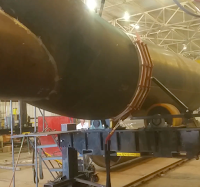 |
| Induction heating coils around large pipe for pre-weld heat treatment. |
Direct Induction
Direct induction heating occurs when the material to be heated is in the direct alternating magnetic field. The frequency of the electromagnetic field and the electric properties of the material determine the penetration depth of the field, thus enabling the localized, near-surface heating of the material.
Comparably high power densities and high heating rates can be achieved. Direct induction heating is primarily used in the metals industry for melting, heating, and heat treatment (hardening, tempering, and annealing).
Indirect Induction
Indirect Induction
With indirect induction heating, a strong electromagnetic field generated by a water- cooled coil induces an eddy current into an electrically conducting material (susceptor), which is in contact with the material to be treated. Indirect induction heating is often used to melt optical glasses in platinum crucibles, to sinter ceramic powders in graphite crucibles, and to melt materials in crucibles prior to drawing crystals. Indirect induction is also used to heat susceptors used for joining operations.